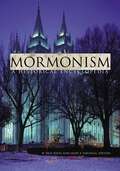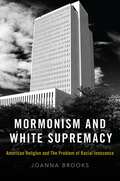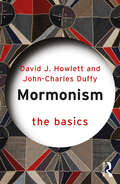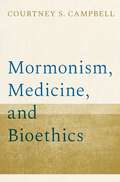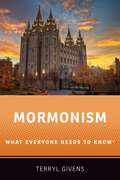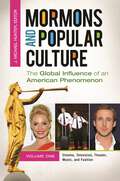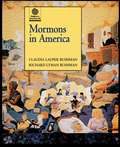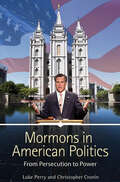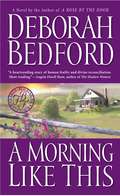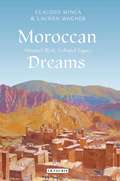- Table View
- List View
Mormonism: A Historical Encyclopedia
by W. Paul Reeve Ardis E. ParshallCovering its historic development, important individuals, and central ideas and issues, this encyclopedia offers broad historical coverage of The Church of Jesus Christ of Latter-day Saints.Mormonism: A Historical Encyclopedia helps readers explore a church that has gone from being an object of ridicule and sometimes violent persecution to a worldwide religion, counting prominent businesspeople and political leaders among its members (including former Massachusetts governor and recent presidential candidate Mitt Romney).The encyclopedia begins with an overview of The Church of Jesus Christ of Latter-day Saints—six essays cover the church's history from Joseph Smith's first vision in 1820 to its current global status. This provides a context for subsequent sections of alphabetically organized entries on key events and key figures in Mormon history. A final section looks at important issues such as the church's organization and government, its teachings on family, Mormonism and blacks, Mormonism and women, and Mormonism and Native Americans. Together, these essays and entries, along with revealing primary sources, portray the Mormon experience like no other available reference work.
Mormonism: A Historical Encyclopedia
by W. Paul Reeve and Ardis E. Parshall, EditorsCovering its historic development, important individuals, and central ideas and issues, this encyclopedia offers broad historical coverage of The Church of Jesus Christ of Latter-day Saints.Mormonism: A Historical Encyclopedia helps readers explore a church that has gone from being an object of ridicule and sometimes violent persecution to a worldwide religion, counting prominent businesspeople and political leaders among its members (including former Massachusetts governor and recent presidential candidate Mitt Romney).The encyclopedia begins with an overview of The Church of Jesus Christ of Latter-day Saints—six essays cover the church's history from Joseph Smith's first vision in 1820 to its current global status. This provides a context for subsequent sections of alphabetically organized entries on key events and key figures in Mormon history. A final section looks at important issues such as the church's organization and government, its teachings on family, Mormonism and blacks, Mormonism and women, and Mormonism and Native Americans. Together, these essays and entries, along with revealing primary sources, portray the Mormon experience like no other available reference work.
Mormonism and White Supremacy: American Religion and The Problem of Racial Innocence
by Joanna BrooksTo this day, churchgoing Mormons report that they hear from their fellow congregants in Sunday meetings that African-Americans are the accursed descendants of Cain whose spirits--due to their lack of spiritual mettle in a premortal existence--were destined to come to earth with a "curse" of black skin. This claim can be made in many Mormon Sunday Schools without fear of contradiction. You are more likely to encounter opposition if you argue that the ban on the ordination of Black Mormons was a product of human racism. Like most difficult subjects in Mormon history and practice, says Joanna Brooks, the priesthood and temple ban on Blacks has been managed carefully in LDS institutional settings with a combination of avoidance, denial, selective truth-telling, and determined silence. As America begins to come to terms with the costs of white privilege to Black lives, this book urges a soul-searching examination of the role American Christianity has played in sustaining everyday white supremacy by assuring white people of their innocence. In Mormonism and White Supremacy, Joanna Brooks offers an unflinching look at her own people's history and culture and finds in them lessons that will hit home for every scholar of American religion and person of faith.
Mormonism and White Supremacy: American Religion and The Problem of Racial Innocence
by Joanna BrooksTo this day, churchgoing Mormons report that they hear from their fellow congregants in Sunday meetings that African-Americans are the accursed descendants of Cain whose spirits--due to their lack of spiritual mettle in a premortal existence--were destined to come to earth with a "curse" of black skin. This claim can be made in many Mormon Sunday Schools without fear of contradiction. You are more likely to encounter opposition if you argue that the ban on the ordination of Black Mormons was a product of human racism. Like most difficult subjects in Mormon history and practice, says Joanna Brooks, the priesthood and temple ban on Blacks has been managed carefully in LDS institutional settings with a combination of avoidance, denial, selective truth-telling, and determined silence. As America begins to come to terms with the costs of white privilege to Black lives, this book urges a soul-searching examination of the role American Christianity has played in sustaining everyday white supremacy by assuring white people of their innocence. In Mormonism and White Supremacy, Joanna Brooks offers an unflinching look at her own people's history and culture and finds in them lessons that will hit home for every scholar of American religion and person of faith.
Mormonism: The Basics (The Basics)
by John Charles Duffy David J HowlettAlthough often regarded as marginal or obscure, Mormonism is a significant American religious minority, numerically and politically. The successes and struggles of this U.S. born religion reveal much about how religion operates in U.S. society. Mormonism: The Basics introduces the teachings, practices, evolution, and internal diversity of this movement, whose cultural icons range from Mitt Romney to the Twilight saga, from young male missionaries in white shirts and ties to polygamous women in pastel prairie dresses. This is the first introductory text on Mormonism that tracks not only the mainstream LDS but also two other streams within the movement—the liberalized RLDS and the polygamous Fundamentalists—thus showing how Mormons have pursued different approaches to defining their identity and their place in society. The book addresses these questions. Are Mormons Christian, and why does it matter? How have Mormons worked out their relationship to the state? How have Mormons diverged in their thinking about gender and sexuality? How do rituals and regulations shape Mormon lives? What types of sacred spaces have Mormons created? What strategies have Mormons pursued to establish a global presence? Mormonism: The Basics is an ideal introduction for anyone wanting to understand this religion within its primarily American but increasingly globalized contexts.
Mormonism: The Basics (The Basics)
by John Charles Duffy David J HowlettAlthough often regarded as marginal or obscure, Mormonism is a significant American religious minority, numerically and politically. The successes and struggles of this U.S. born religion reveal much about how religion operates in U.S. society. Mormonism: The Basics introduces the teachings, practices, evolution, and internal diversity of this movement, whose cultural icons range from Mitt Romney to the Twilight saga, from young male missionaries in white shirts and ties to polygamous women in pastel prairie dresses. This is the first introductory text on Mormonism that tracks not only the mainstream LDS but also two other streams within the movement—the liberalized RLDS and the polygamous Fundamentalists—thus showing how Mormons have pursued different approaches to defining their identity and their place in society. The book addresses these questions. Are Mormons Christian, and why does it matter? How have Mormons worked out their relationship to the state? How have Mormons diverged in their thinking about gender and sexuality? How do rituals and regulations shape Mormon lives? What types of sacred spaces have Mormons created? What strategies have Mormons pursued to establish a global presence? Mormonism: The Basics is an ideal introduction for anyone wanting to understand this religion within its primarily American but increasingly globalized contexts.
Mormonism, Empathy, and Aesthetics: Beholding the Body
by Gary EttariThis book analyzes the role that the physical body plays in foundational Mormon doctrine, and claims that such an analysis reveals a model of empathy that has significant implications for the field of Mormon aesthetics. This volume achieves three main goals: It elucidates the Mormonism's relationship with the body, it illuminates Mormonism’s traditional approaches to understanding and appreciating art, and it suggests that the body as Mormonism conceives of it allows for the employment of an aesthetic framework rooted in bodily empathy rather than traditional Christian or Mormon moral values per se. In support of this argument, several chapters of the book apply Mormonism’s theology of the body to paintings and poems by contemporary Mormon artists and writers. An examination of those works reveals that the seeds of a new Mormon aesthetic are germinating, but have yet to significantly shift traditional Mormon thought regarding the role and function of art.
Mormonism For Dummies
by Jana Riess Christopher Kimball BigelowGet the facts on temples, tithing, missions, and caffeine Mormon doctrines, rituals, and history, demystified at last! Mormonism, or the LDS Church, is one of the world's fastest growing religions. But unless you were raised a Mormon, you probably don't have a clear picture of LDS beliefs and practices. Covering everything from Joseph Smith and the Book of Mormon to tithing and family home evening, this friendly guide will get you up to speed in no time. Discover: * How the LDS Church differs from other Christian churches * What Mormons believe * What happens in Mormon temples and meetinghouses * The history of the LDS Church * LDS debates on race, women, and polygamy
Mormonism, Medicine, and Bioethics
by Courtney S. CampbellMormonism, Medicine, and Bioethics provides the first comprehensive treatment of principles and positions on questions of bioethics encountered by members, professionals, and ecclesiastical leaders of The Church of Jesus Christ of Latter-day Saints (LDS or Mormon). The book addresses three fundamental features of a coherent religious bioethics: precepts for practical decision-making, general ethical principles, and core religious convictions that give a distinctive motivation for personal, communal, and professional integrity. LDS ethical principles of love, hospitality to strangers, covenantal solidarity, justice, and moral agency are integrated with central topics in bioethics including abortion, genetic testing and enhancements, in vitro fertilization, medical assisted death, medicinal marijuana, neonatal intensive care, organ donation, preventive health care, universal access to care, and vaccinations. This book uses first-person experiences to give voice to the lived moral realities of Latter-day Saints as they experience difficult and wrenching ethical questions and choices as persons, family members, community members, professionals, and as citizens within the context of their distinctive faith convictions. It situates these communal conversations within the broader discourse of bioethics and thereby supports both bioethics and religious literacy. Mormonism, Medicine, and Bioethics also examines circumstances in which The Church of Jesus Christ of Latter-day Saints engages in a moral witness of its values on matters of public policy, such as legalization of physician-assisted death, of elective abortion, and of medicinal marijuana. The book concludes with a distinctive normative argument on why LDS ethical principles and practices require support of universal access to an adequate level of health care for all persons. It provides an appendix of significant LDS ecclesiastical policies on medical, health, and moral issues, making it a definitive educational and reference compilation.
Mormonism, Medicine, and Bioethics
by Courtney S. CampbellMormonism, Medicine, and Bioethics provides the first comprehensive treatment of principles and positions on questions of bioethics encountered by members, professionals, and ecclesiastical leaders of The Church of Jesus Christ of Latter-day Saints (LDS or Mormon). The book addresses three fundamental features of a coherent religious bioethics: precepts for practical decision-making, general ethical principles, and core religious convictions that give a distinctive motivation for personal, communal, and professional integrity. LDS ethical principles of love, hospitality to strangers, covenantal solidarity, justice, and moral agency are integrated with central topics in bioethics including abortion, genetic testing and enhancements, in vitro fertilization, medical assisted death, medicinal marijuana, neonatal intensive care, organ donation, preventive health care, universal access to care, and vaccinations. This book uses first-person experiences to give voice to the lived moral realities of Latter-day Saints as they experience difficult and wrenching ethical questions and choices as persons, family members, community members, professionals, and as citizens within the context of their distinctive faith convictions. It situates these communal conversations within the broader discourse of bioethics and thereby supports both bioethics and religious literacy. Mormonism, Medicine, and Bioethics also examines circumstances in which The Church of Jesus Christ of Latter-day Saints engages in a moral witness of its values on matters of public policy, such as legalization of physician-assisted death, of elective abortion, and of medicinal marijuana. The book concludes with a distinctive normative argument on why LDS ethical principles and practices require support of universal access to an adequate level of health care for all persons. It provides an appendix of significant LDS ecclesiastical policies on medical, health, and moral issues, making it a definitive educational and reference compilation.
Mormonism: A Very Short Introduction (Very Short Introductions)
by Richard Lyman BushmanBeginning with a handful of members in 1830, the church that Joseph Smith founded has grown into a world-wide organization with over 12 million adherents, playing prominent roles in politics, sports, entertainment, and business. Yet they are an oddity. They are considered wholesome, conservative, and friendly on one hand, and clannish, weird, and self-righteous on the other. Mormonism: A Very Short Introduction explains who Mormons are: what they believe and how they live their lives. Written by Richard Lyman Bushman, an eminent historian and practicing Mormon, this compact, informative volume ranges from the history of the Church of Jesus Christ of Latter-day Saints to the contentious issues of contemporary Mormonism. Bushman argues that Joseph Smith still serves as the Mormons' Moses. Their everyday religious lives are still rooted in his conceptions of true Christianity. They seek revelation to solve life's problems just as he did. They believe the authority to seal families together for eternity was restored through him. They understand their lives as part of a spiritual journey that started in a "council in heaven" before the world began just as he taught. Bushman's account also describes the tensions and sorrows of Mormon life. How are Mormons to hold on to their children in a world of declining moral standards and rampant disbelief? How do rational, educated Mormons stand up to criticisms of their faith? How do single Mormons fare in a church that emphasizes family life? The book also examines polygamy, the various Mormon scriptures, and the renegade fundamentalists who tarnish the LDS image when in fact they're not members. In a time when Mormons such as Mitt Romney and Harry Reid are playing prominent roles in American society, this engaging introduction enables readers to judge for themselves how Mormon teachings shape the character of believers. About the Series: Oxford's Very Short Introductions series offers concise and original introductions to a wide range of subjects--from Islam to Sociology, Politics to Classics, Literary Theory to History, and Archaeology to the Bible. Not simply a textbook of definitions, each volume in this series provides trenchant and provocative--yet always balanced and complete--discussions of the central issues in a given discipline or field. Every Very Short Introduction gives a readable evolution of the subject in question, demonstrating how the subject has developed and how it has influenced society. Eventually, the series will encompass every major academic discipline, offering all students an accessible and abundant reference library. Whatever the area of study that one deems important or appealing, whatever the topic that fascinates the general reader, the Very Short Introductions series has a handy and affordable guide that will likely prove indispensable.
MORMONISM WENK C: What Everyone Needs to Know® (What Everyone Needs To KnowRG)
by Terryl GivensMormonism, or the Church of Jesus Christ of Latter-day Saints, is America's most successful-and most misunderstood-home grown religion. The church today boasts more than 15 million members worldwide, a remarkable feat in the face of increasing secularity. The growing presence of Mormonism shows no signs of abating, as the makeup of its membership becomes progressively diverse. The heightened contemporary relevance and increasingly global membership of the Church solidifies Mormonism as a religious group much deserving of awareness. Covering the origins, history, and modern challenges of the church, Mormonism: What Everyone Needs to Know offers readers a brief, authoritative guide to one of the fastest growing faith groups of the twenty-first century in a reader-friendly format, providing answers to questions such as: What circumstances gave rise to the birth of Mormonism? Why was Utah chosen as a place of refuge? Do you have to believe the Book of Mormon to be a Latter-day Saint? Why do women not hold the priesthood? How wealthy is the church and how much are top leaders paid? Written by a believer and the premier scholar of the Latter-day Saints faith, this remarkably readable introduction provides a sympathetic but unstinting account of one of the few religious traditions to maintain its vitality and growth in an era of widespread disaffiliation.
Mormons and Popular Culture [2 volumes]: The Global Influence of an American Phenomenon [2 volumes]
by J. Michael HunterMany people are unaware of how influential Mormons have been on American popular culture. This book parts the curtain and looks behind the scenes at the little-known but important influence Mormons have had on popular culture in the United States and beyond.Mormons and Popular Culture: The Global Influence of an American Phenomenon provides an unprecedented, comprehensive treatment of Mormons and popular culture. Authored by a Mormon studies librarian and author of numerous writings regarding Mormon folklore, culture, and history, this book provides students, scholars, and interested readers with an introduction and wide-ranging overview of the topic that can serve as a key reference book on the topic.The work contains fascinating coverage on the most influential Mormon actors, musicians, fashion designers, writers, artists, media personalities, and athletes. Some topics—such as the Mormon influence at Disney, and how Mormon inventors have assisted in transforming American popular culture through the inventions of television, stereophonic sound, video games, and computer-generated animation—represent largely unknown information. The broad overview of Mormons and American popular culture offered can be used as a launching pad for further investigation; researchers will find the references within the book's well-documented chapters helpful.
Mormons and Popular Culture [2 volumes]: The Global Influence of an American Phenomenon [2 volumes]
by J. Michael Hunter, EditorMany people are unaware of how influential Mormons have been on American popular culture. This book parts the curtain and looks behind the scenes at the little-known but important influence Mormons have had on popular culture in the United States and beyond.Mormons and Popular Culture: The Global Influence of an American Phenomenon provides an unprecedented, comprehensive treatment of Mormons and popular culture. Authored by a Mormon studies librarian and author of numerous writings regarding Mormon folklore, culture, and history, this book provides students, scholars, and interested readers with an introduction and wide-ranging overview of the topic that can serve as a key reference book on the topic.The work contains fascinating coverage on the most influential Mormon actors, musicians, fashion designers, writers, artists, media personalities, and athletes. Some topics—such as the Mormon influence at Disney, and how Mormon inventors have assisted in transforming American popular culture through the inventions of television, stereophonic sound, video games, and computer-generated animation—represent largely unknown information. The broad overview of Mormons and American popular culture offered can be used as a launching pad for further investigation; researchers will find the references within the book's well-documented chapters helpful.
Mormons and the Bible: The Place of the Latter-day Saints in American Religion
by Philip L. BarlowPhilip L. Barlow offers an in-depth analysis of the approaches taken to the Bible by major Mormon leaders, from its beginnings to the present. He shows that Mormon attitudes toward the Bible comprise an extraordinary mix of conservative, liberal, and radical ingredients: an almost fundamentalist adherence to the King James Version co-exists with belief in the possibility of new revelation and surprising ideas about the limits of human language. Barlow's exploration takes important steps toward unraveling the mystery of this quintessential American religious phenomenon. This updated edition of Mormons and the Bible includes an extended bibliography and a new preface, casting Joseph Smith's mission into a new frame and treating evolutions in Mormonism's biblical usage in recent decades.
Mormons and the Bible: The Place of the Latter-day Saints in American Religion
by Philip L. BarlowPhilip L. Barlow offers an in-depth analysis of the approaches taken to the Bible by major Mormon leaders, from its beginnings to the present. He shows that Mormon attitudes toward the Bible comprise an extraordinary mix of conservative, liberal, and radical ingredients: an almost fundamentalist adherence to the King James Version co-exists with belief in the possibility of new revelation and surprising ideas about the limits of human language. Barlow's exploration takes important steps toward unraveling the mystery of this quintessential American religious phenomenon. This updated edition of Mormons and the Bible includes an extended bibliography and a new preface, casting Joseph Smith's mission into a new frame and treating evolutions in Mormonism's biblical usage in recent decades.
Mormons in America (Religion in American Life)
by Claudia Lauper Bushman Richard Lyman BushmanMormonism is one of the world's fastest growing religions, doubling its membership every 15 years. The Church of Jesus Christ of Latter-day Saints (the formal denomination of the Mormon church) is now 10 million strong, with more than half of its membership coming from outside the United States. More than 88 million copies of The Book of Mormon have been printed, and it has been translated into more than 50 languages. Mormons in America tells the tumultuous story of this religious group, from its humble origins in small-town New York State in 1830 to its present heyday. Claudia and Richard Bushman introduce us to charismatic leaders like Joseph Smith and Brigham Young, go deep behind Mormon rites and traditions, take us along the adventurous trail of the Mormon pioneers into the West, evoke the momentous erection of Salt Lake City in the desert, and draw us into the dozens of skirmishes, verbal attacks, and court battles between Mormons and their neighbors, other religions, the media, and the American government. Religion in American Life explores the evolution, character, and dynamic of organized religion in America from 1500 to the present day. Written by distinguished historians of religion, these books weave together the varying stories that compose the religious fabric of the United States, from Puritanism to alternative religious practices. Primary source material coupled with handsome illustrations and lucid text make these books essential in any exploration of America's diverse nature. Each book includes a chronology, suggestions for further reading, and an index.
Mormons in America (Religion in American Life)
by Richard Lyman Bushman Claudia Lauper BushmanMormonism is one of the world's fastest growing religions, doubling its membership every 15 years. The Church of Jesus Christ of Latter-day Saints (the formal denomination of the Mormon church) is now 10 million strong, with more than half of its membership coming from outside the United States. More than 88 million copies of The Book of Mormon have been printed, and it has been translated into more than 50 languages. Mormons in America tells the tumultuous story of this religious group, from its humble origins in small-town New York State in 1830 to its present heyday. Claudia and Richard Bushman introduce us to charismatic leaders like Joseph Smith and Brigham Young, go deep behind Mormon rites and traditions, take us along the adventurous trail of the Mormon pioneers into the West, evoke the momentous erection of Salt Lake City in the desert, and draw us into the dozens of skirmishes, verbal attacks, and court battles between Mormons and their neighbors, other religions, the media, and the American government. Religion in American Life explores the evolution, character, and dynamic of organized religion in America from 1500 to the present day. Written by distinguished historians of religion, these books weave together the varying stories that compose the religious fabric of the United States, from Puritanism to alternative religious practices. Primary source material coupled with handsome illustrations and lucid text make these books essential in any exploration of America's diverse nature. Each book includes a chronology, suggestions for further reading, and an index.
Mormons in American Politics: From Persecution to Power
by Luke Perry Christopher CroninThis book provides a comprehensive explanation of how the Mormons have transformed from a hated and persecuted fringe group to a well-established world religion with viable candidates for all levels of American government.The Mormon tradition is unfamiliar and mysterious to most Americans outside of the religion, and understandably generates much curiosity. Mormons in American Politics: From Persecution to Power provides an intellectual foundation of Mormon development and emergence in politics, comprehensively examining significant issues and developments from historical, theological, cultural, and modern perspectives. The work analyzes diverse, contemporary topics including Mormons in popular culture, Mormon understandings of the Constitution, the Mormon welfare program, Mormon opposition to same-sex marriage, and the global expansion of Mormonism.The book is ideal for scholars and students of American politics, history, and culture; Mormon studies; religious studies; and religion and politics; as well as general readers who are interested in Mormon religion and culture or the rise of Mormon figures in mainstream American politics.
Mormons in American Politics: From Persecution to Power
by Luke Perry Christopher CroninThis book provides a comprehensive explanation of how the Mormons have transformed from a hated and persecuted fringe group to a well-established world religion with viable candidates for all levels of American government.The Mormon tradition is unfamiliar and mysterious to most Americans outside of the religion, and understandably generates much curiosity. Mormons in American Politics: From Persecution to Power provides an intellectual foundation of Mormon development and emergence in politics, comprehensively examining significant issues and developments from historical, theological, cultural, and modern perspectives. The work analyzes diverse, contemporary topics including Mormons in popular culture, Mormon understandings of the Constitution, the Mormon welfare program, Mormon opposition to same-sex marriage, and the global expansion of Mormonism.The book is ideal for scholars and students of American politics, history, and culture; Mormon studies; religious studies; and religion and politics; as well as general readers who are interested in Mormon religion and culture or the rise of Mormon figures in mainstream American politics.
A Morning Like This (Wheeler Romance Ser.)
by Deborah BedfordDavid and Abby Treasure seem to have everything together: a perfect marriage, a perfect son, and a perfect life. But one simple phone call turns their world upside down. Years ago, David had an affair outside of his marriage, and though he never knew it, the affair produced a daughter. Now his former lover calls with heartbreaking news: his daughter is dying of leukemia. Her only hope for survival is a bone marrow transplant-from David or his son. Can David and Abby set aside their betrayal and anger to save a little girl's life? If they can make it through, they may find that their love for one another and their faith in God can be redeemed . . . and grow stronger than ever before.
Moroccan Dreams: Oriental Myth, Colonial Legacy (International Library of Human Geography)
by Lauren Wagner Claudio MincaMorocco has long been a mythic land firmly rooted in the European imagination. For more than a century it has been appropriated by writers, artists and explorers such as Pierre Loti, Edith Wharton, Eugene Delacroix, Paul Bowles and Elias Canetti. In Moroccan Dreams, the authors explore the ways in which this legacy is being recreated for nostalgic consumption by those seeking the authentic experience of the orient. Taking the reader on a tour, both real and imaginary, to sites that form the quintessential Morrocan experience, including the capital city Rabat, the medina at Fez, Marakkech, the Kasbah, the desert, Tangier, and the gentrified colonial elegance of Essaouira, they unravel the elements that are so appealing about this imagined experience. Richly illustrated, Moroccan Dreams provides an enticing journey that will delight all those captivated by the culture and spatialities of the European colonial enterprise and all those enamoured of Morocco and its extraordinary geographies.
Moroccan Feminist Discourses (Comparative Feminist Studies)
by F. SadiqiBoth a scholarly and personal critique of current feminist Moroccan discourses, this book is a call for a larger-than-Islam framework that accommodates the Berber dimension. Sadiqi argues that current feminist discourse, both secular and Islamic ones, are not only divergent but limit the rich heritage, knowledge, and art of Berber women.
Moroccan Monarchy and the Islamist Challenge: Maintaining Makhzen Power
by M. DaadaouiThis book examines the factors behind the survival and persistence of monarchical authoritarianism in Morocco and argues that state rituals of power affect the opposition forces ability to challenge the monarchy.
Morphogenesis of Symbolic Forms: Meaning in Music, Art, Religion, and Language (Lecture Notes in Morphogenesis)
by Wolfgang WildgenIn the present book, the starting line is defined by a morphogenetic perspective on human communication and culture. The focus is on visual communication, music, religion (myth), and language, i.e., on the “symbolic forms” at the heart of human cultures (Ernst Cassirer). The term “morphogenesis” has more precisely the meaning given by René Thom (1923-2002) in his book “Morphogenesis and Structural Stability” (1972) and the notions of “self-organization” and cooperation of subsystems in the “Synergetics” of Hermann Haken (1927- ). The naturalization of communication and cultural phenomena is the favored strategy, but the major results of the involved disciplines (art history, music theory, religious science, and linguistics) are respected.Visual art from the Paleolithic to modernity stands for visual communication. The present book focuses on studies of classical painting and sculpture (e.g., Leonardo da Vinci, William Turner, and Henry Moore) and modern art (e.g., Jackson Pollock and Joseph Beuys). Musical morphogenesis embraces classical music (from J. S. Bach to Arnold Schönberg) and political songwriting (Bob Dylan, Leonhard Cohen). The myths of pre-literary societies show the effects of self-organization in the re-assembly (bricolage) of traditions. Classical polytheistic and monotheistic religions demonstrate the unfolding of basic germs (religious attractors) and their reduction in periods of crisis, the self-organization of complex religious networks, and rationalized macro-structures (in theologies). Significant tendencies are analyzed in the case of Buddhism and Christianism. Eventually, a holistic view of symbolic communication and human culture emerges based on state-of-the-art in evolutionary biology, cognitive science, linguistics, and semiotics (philosophy of symbolic forms).
